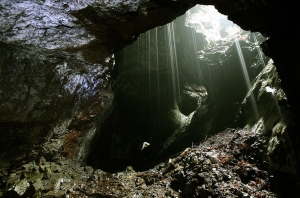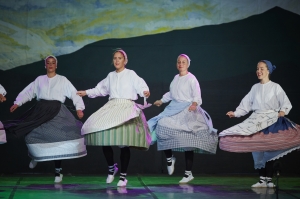Basque mythology
- Andrés ORTIZ - OSÉS (Professor of Hermeneutics, University of Deusto)
- 15/ 10/ 2001
In the following article, Andrés Ortiz - Osés, professor of hermeneutics and member of the Círculo de Eranos, considers why the Basque cosmic vision or mythology should be considered matriarchal or communalist, relating his own studies with others carried out in various fields.

For our purposes, we can distinguish between myths as inventions or fiction-Aitor, Amaya, etc.-and mythology as a revelation or inventory of the oral tradition: a symbolic view of the world, in which the traditional conception of the cosmos of a human group is transmitted.
Basque mythology appears here as a symbolic and religious Weltanschauung and, therefore one which belongs to the cultural baggage of a people or human grouping. In this regard, we intellectuals should protect cultural assets, such as mythology or language, from being used for political purposes either as proof of a purist identity by Basque nationalists or of an impure difference by Spanish nationalism. In point of fact, a cultural contribution should be an invitation to communication and not to incommunication; to dialogue and not to intolerance; to fraternisation and not to war.
As I have shown in various essays, Basque mythology is not a patriarchal mythology like that of Indo-European or Semitic cultures, but rather a matriarchal mythology of a pre-Indo European type (like Basque culture itself). This can essentially be seen in the fact that the (offset) centre of the Basque mythical-religious pantheon is cohabited by a goddess: the mother goddess Armari, who is an "omnirelative" matriarchal divinity, in that she gives birth to everything and relates everything: so, for example, the four elements (earth, water, fire and air), and also the four kingdoms (mineral, vegetable, animal-human and divine).

The Basque goddess Amari might be said to be the cosmic earth, since she personifies the whole universe, which is her materialisation. This radically matriarchal-feminine universe is incarnated by Amari, who extends the all-embracing reality between the Telleric-Lunar and the Celestial-Solar, the down and internal and the up or external, the pale mirror that reflects death and the golden comb that regenerates life. In this way, the goddess Amari intermediates between the opposites in her figure, and is therefore the maternal-material of all reality all and the religious or binding ancestor of opposites.
The opposites comprising the symbolic figure of Amari are represented in Basque mythology, as compiled by J. M. Barandiarán, by two essential categories: the category of adur as a magic power or spirit-wind and the category of indar as a physical force or blow-of-light, which the young mythologist/linguist Jon Baltza has interpreted respectively as the invisible and the visible. The first element corresponds to the matriarchal-feminine pedestal of the cosmos, the second represents the patriarchal-masculine epi-phenomenon to which the phallic accompaniments of Amari (Aker, Maju or Sugaar) belong. For this reason at the akelarre, the sexual power of the akerra or male goat is exalted, but at the service of the fecundity/fertility of the mother earth and, consequently, of Amari and her kingdom of witches or sorgiñas.
Where, then, should we locate-in temporal and spatial terms-this mythological imagery? Mythology (Basque) does not occupy a temporal-spatial location, since it transcends typical time and space in its archetypical or transcendental horizon. In any case, its matriarchal denotation and its naturalist and communalist connotations, differentiate it, as we have seen, from patriarchal mythology - which is rationalist and individualist. In this regard, José M. Barandiarán, who made a compilation of this mythology in Basque areas on either side of the Pyrenees, tried to seek a cultural connection between the Basque mythology of Amari and Palaeolithic cave paintings of animals (c. 25,000 B.C.E.), while I myself have tried to correlate Basque mythology with the proto-agricultural Weltanschauungs of the Neolithic era (around 5,000 B.C.E.). Caro Baroja, in turn tried to locate the emergence of Basque mythology in the Bronze Age (c. 2000 B.C.E.). Jorge Oteiza stands out, in that he tried to place Basque mythology at the end of the Palaeolithic era (c.13,000 B.E.C.), in a shepherding and hunting environment, open to the celestial mother-gap: a hypothesis that may have some aesthetic-though not anthropological-interest.
It is undoubtedly strange that despite differences in the symbolic location of Basque mythology, all writers appear to coincide in the matricial vision of the world inherent to Basque mythology. We should therefore consider this to be a matriarchal mythology.








